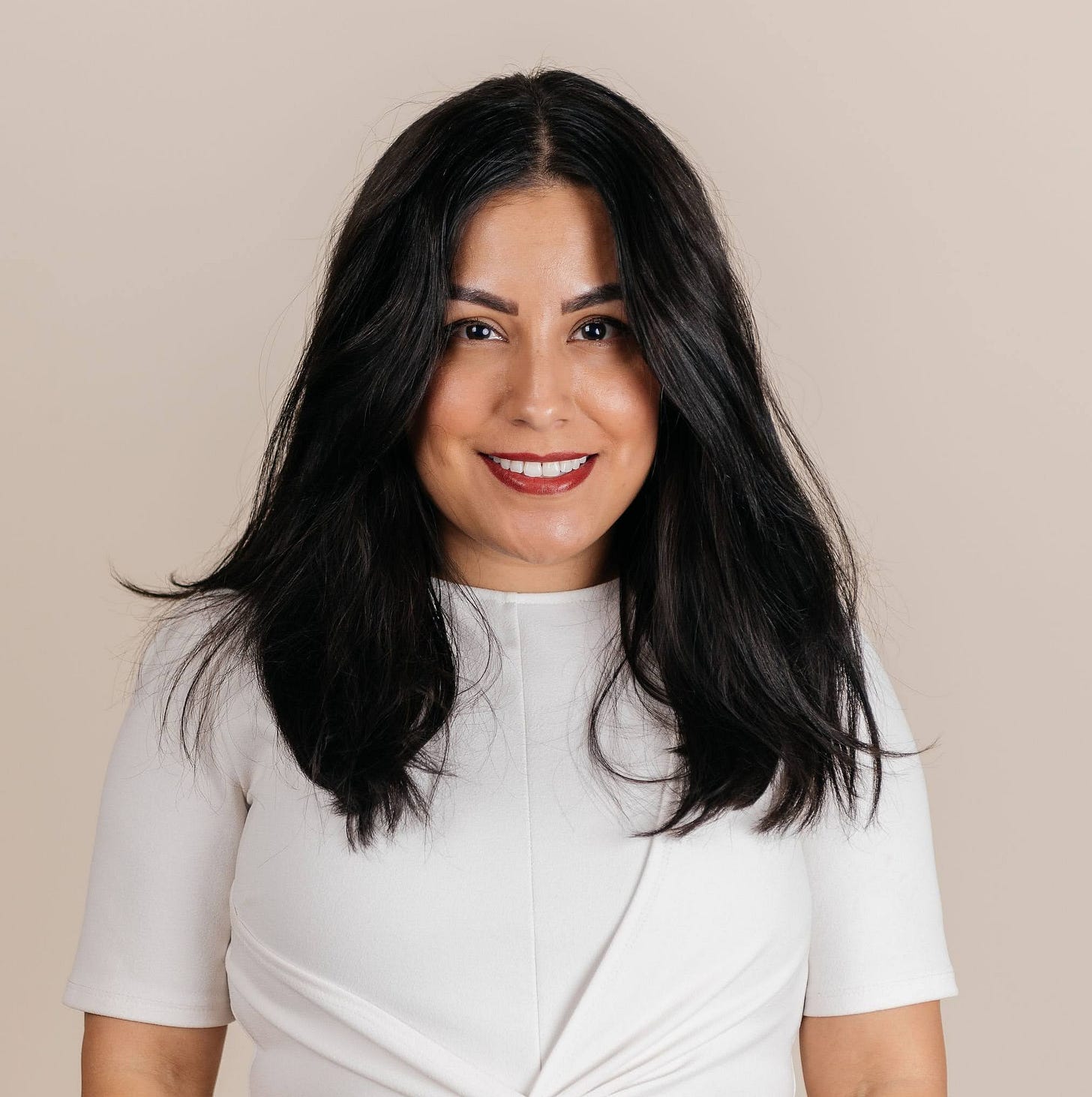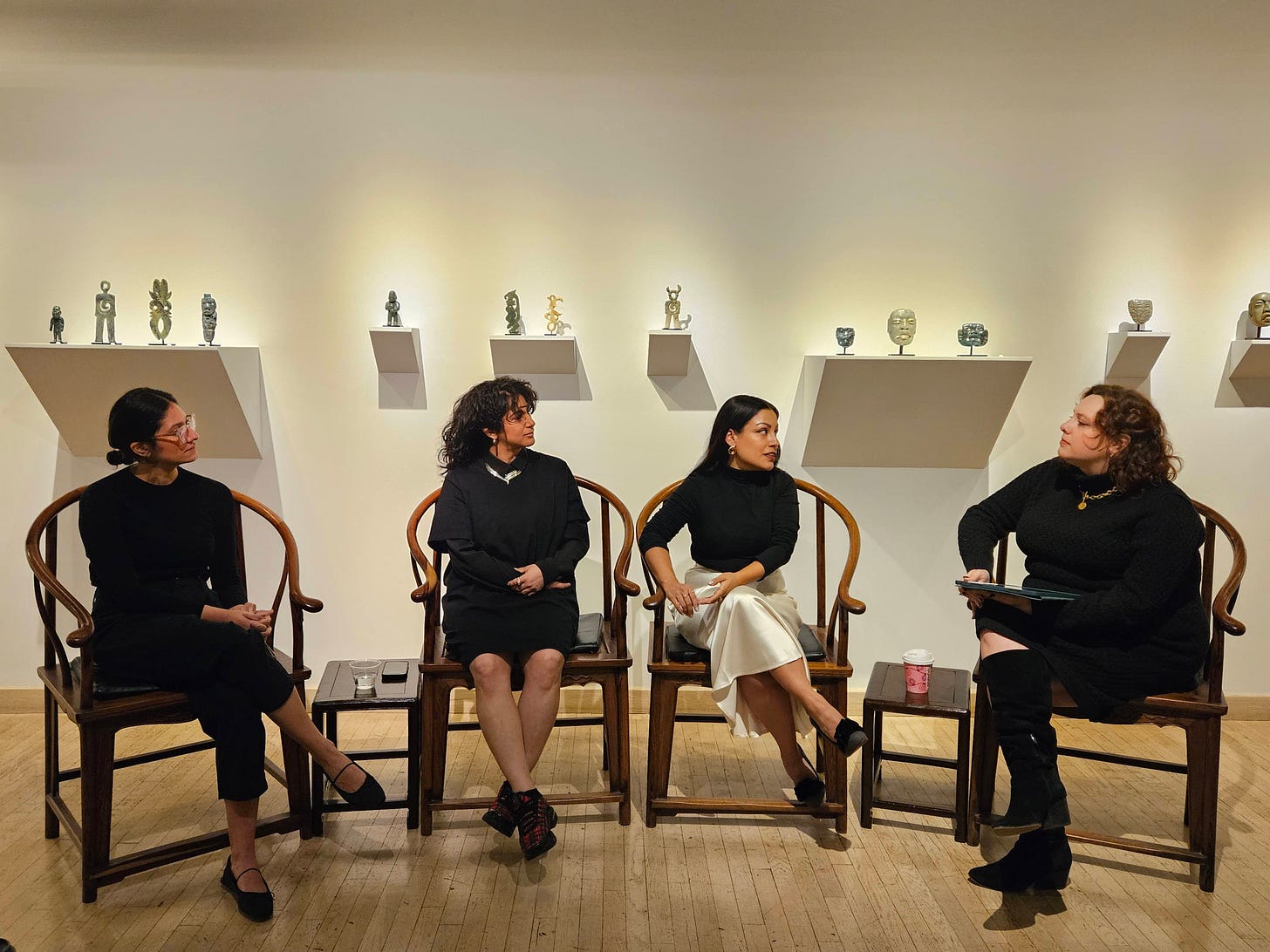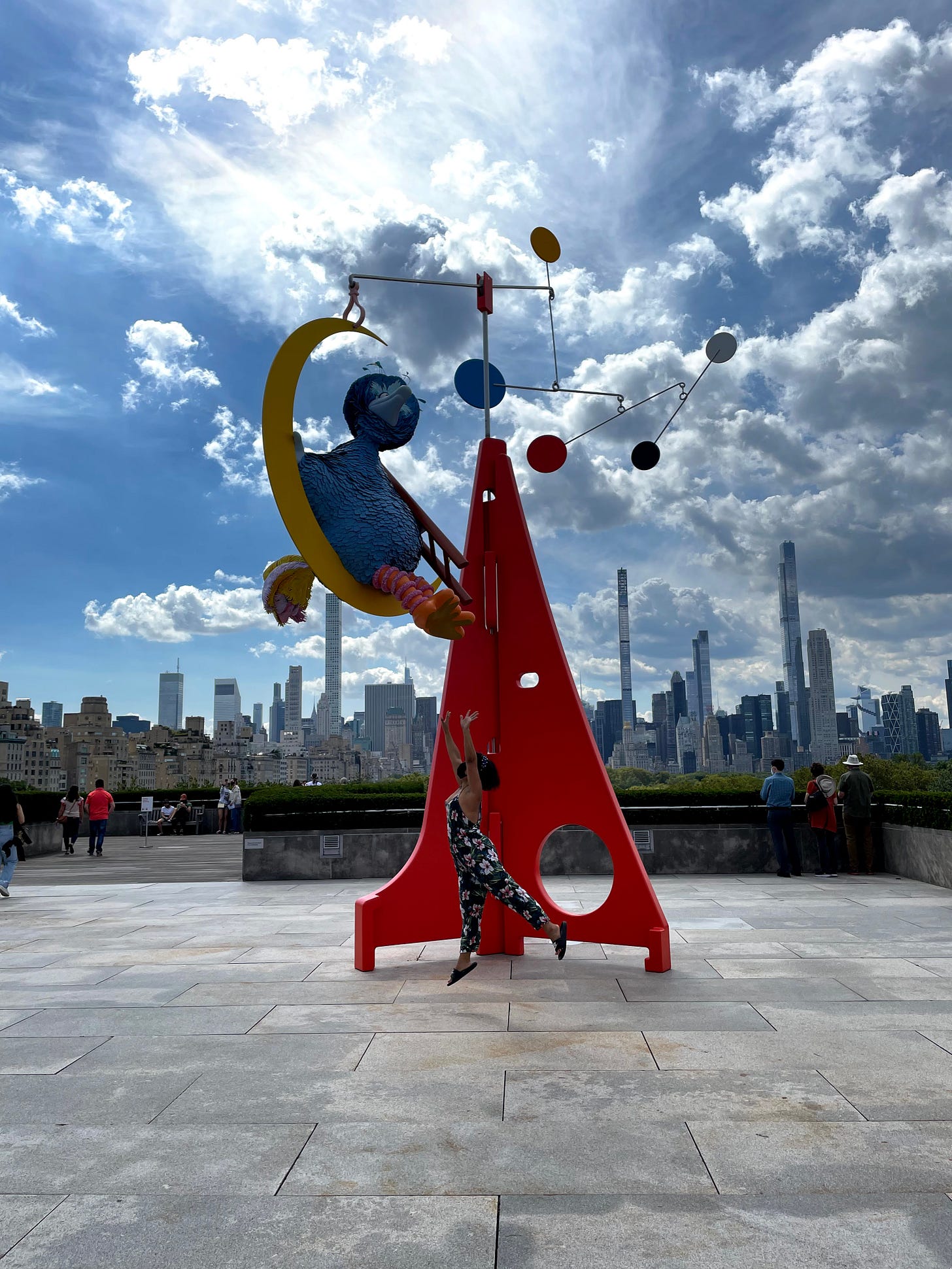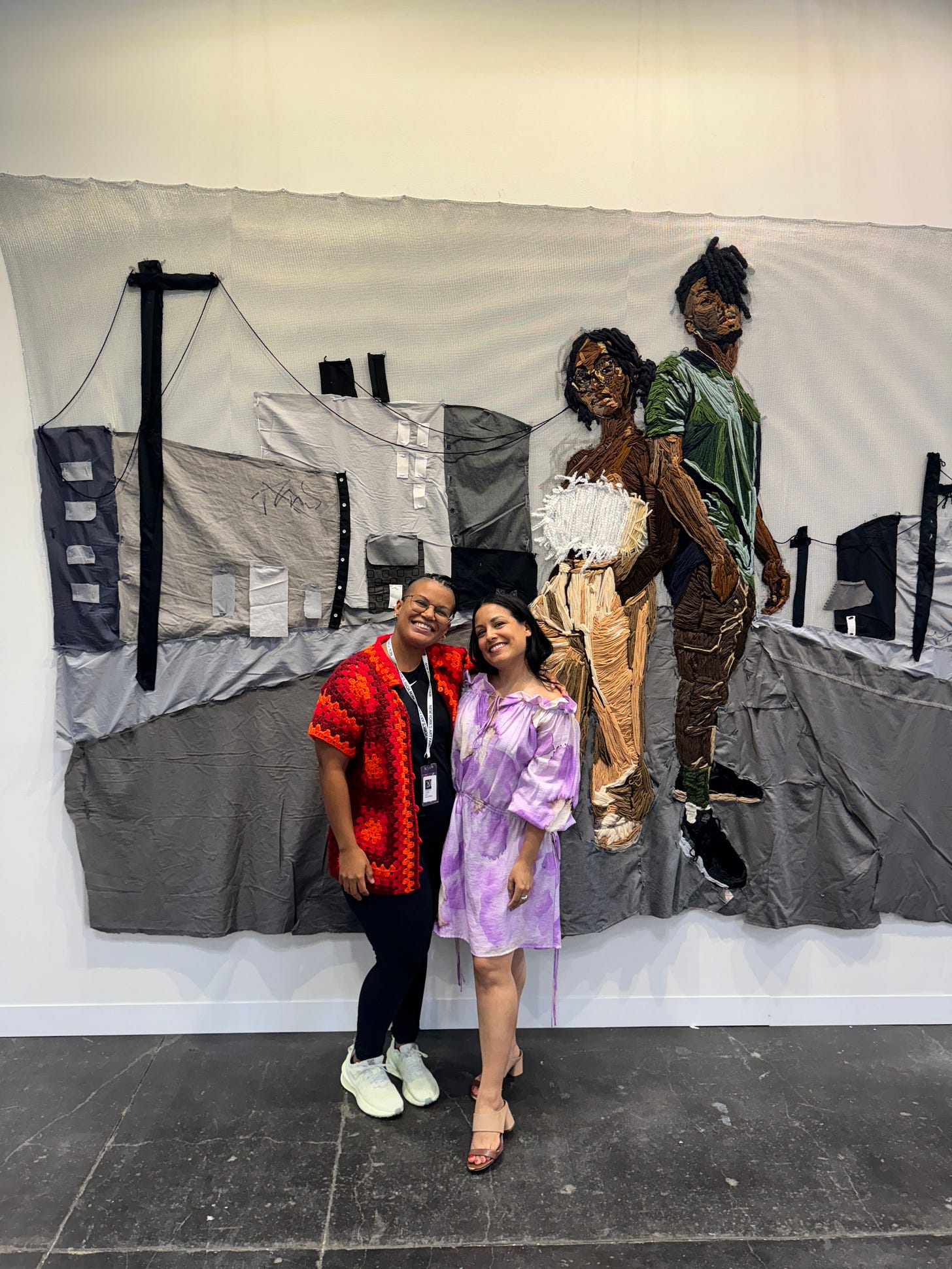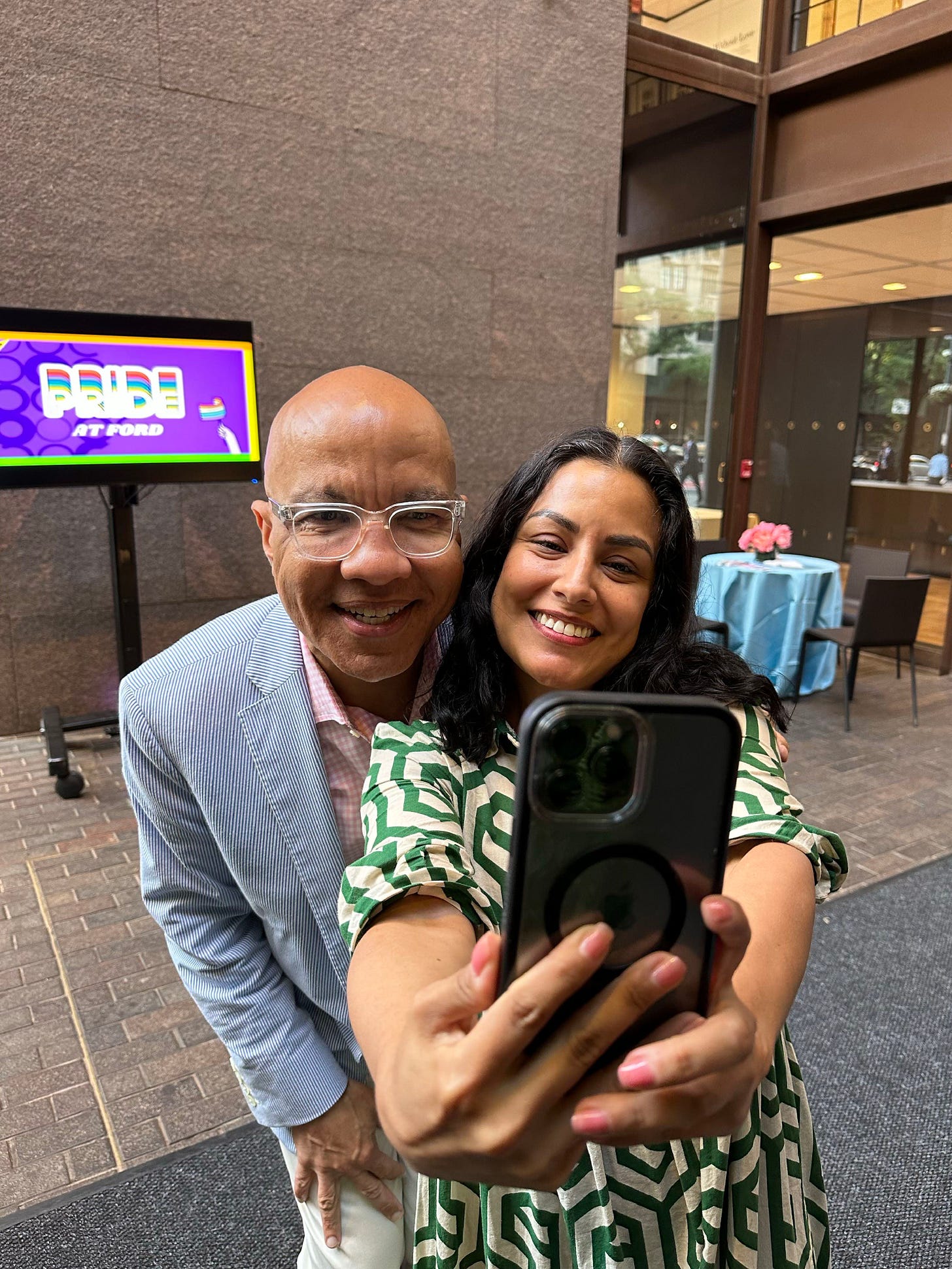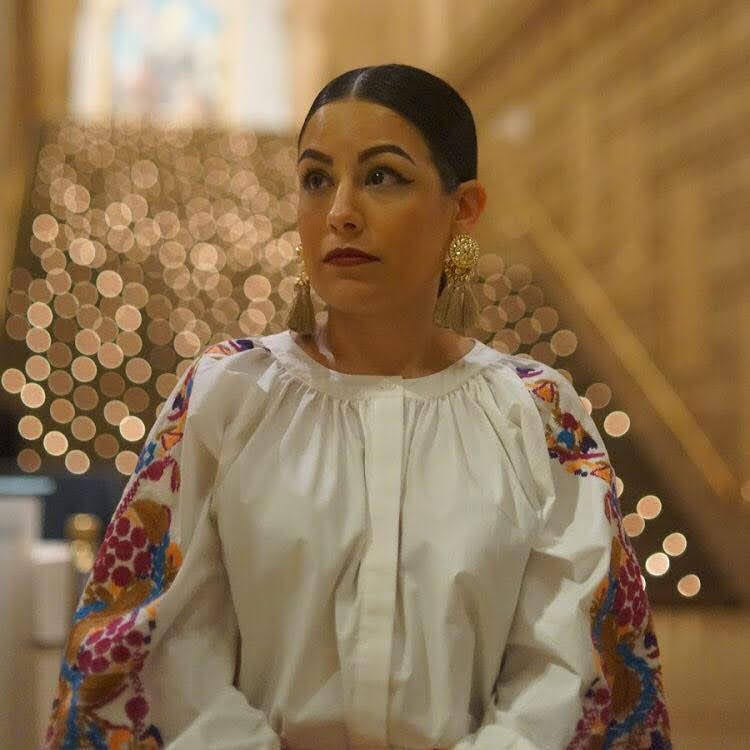In conversation with: Karen Vidangos
En conversación con: Karen Vidangos (versión en español abajo)
In the dynamic realm of the arts, Karen Vidangos has emerged as a prominent advocate for Latinx voices. Known online as Latina in Museums and currently serving as the Senior Social Media Manager at the Metropolitan Museum of Art in NYC, Karen leverages social media to elevate diverse narratives within the art world.
In this interview, Karen shares with us her journey into the world of social media, discusses her impactful projects—including Latina in Museums and the Latinx Art Collective—and explores the exciting role of digital platforms in shaping the future of the arts sector.
Q: Karen, you’ve built such an impressive career in the art world. Before we dive into your work, could you share a bit more about yourself?
Karen Vidangos: I grew up in a household where creativity was always encouraged. My parents fostered curiosity and imagination through music, reading, and writing, which sparked my lifelong love of art. That foundation eventually led me to museums, where I discovered a place that beautifully combined history, culture, and creativity.
Growing up in the DC metropolitan area, I was fortunate to be surrounded by incredible museums like the National Gallery of Art, the National Museum of Women in the Arts, and the Smithsonian. I vividly remember sitting alone at the National Gallery of Art, captivated by a Peter Paul Rubens painting, and realizing that museums were where I felt happiest. From that moment, I knew I wanted to find a way to make them a part of my career.
Q: You studied Art History and Museum Studies at university. What drew you to social media as a career path within the arts?
Karen Vidangos: During my graduate studies, I saw how powerful digital platforms could be in connecting people to art and museum spaces. Social media felt accessible—it allowed me to break down institutional barriers and bring art to people who might not feel museums are for them. I was drawn to its immediacy and reach, but more than that, I saw an opportunity to reshape conversations about who museums are for and whose stories get told.
“During my graduate studies, I saw how powerful digital platforms could be in connecting people to art and museum spaces. Social media felt accessible—it allowed me to break down institutional barriers and bring art to people who might not feel museums are for them”
Q: Online you are known as “Latina in Museums,” and you've become an important voice for underrepresented perspectives in the arts. What led you to start this initiative, and what impact do you hope it has?
Karen Vidangos: I started Latina in Museums because I didn’t see people who looked like me reflected in museum spaces online. While there are certainly Black and Brown creators in the art and museum world, their work often doesn’t receive the same visibility or recognition as their white counterparts. When I first looked for influencers in this space, Latinas weren’t as prominent or easy to find. That realization inspired me to put myself out there—not just to represent myself, but to create visibility for my community.
By sharing my personal experiences navigating the museum field, I hope others see my journey and think, “If she can do it, I can too.” I also wanted to demystify what it looks like to work in museums and show that there’s space for us in these institutions.
“I started Latina in Museums because I didn’t see people who looked like me reflected in museum spaces online…That realization inspired me to put myself out there—not just to represent myself, but to create visibility for my community”
Q: What’s one common misconception or stereotype about working in social media that you wish people knew wasn’t true?
Karen Vidangos: That it’s “just posting.” There’s an immense amount of strategy, creativity, and collaboration involved in building successful campaigns. It requires understanding your audience, institutional goals, cultural trends, and data analytics while staying adaptable. Social media work is a lot more complex than people often realize—it’s storytelling, community building, and marketing all rolled into one.
“Social media work is a lot more complex than people often realize—it’s storytelling, community building, and marketing all rolled into one”
Q: Of all the social media campaigns you’ve worked on, which one stands out as your favorite, and why?
Karen Vidangos: One of my favorite campaigns was for the 2019 Portrait of a Nation Gala at the National Portrait Gallery. It was such an exciting event, honoring incredible figures like Lin-Manuel Miranda, Anna Wintour, and Earth, Wind & Fire. Michelle Obama presented Lin-Manuel’s award, and I’ll never forget when I was introduced to her earlier that evening and she hugged me—it was surreal!
Covering the event on social media was rewarding because it combined live storytelling with a deeper focus on the portraits and their significance. The energy of the evening and the audience’s response to the content made it truly unforgettable.
Q: How do you think museums will evolve in the digital space over the next 10 years?
Karen Vidangos: I think we’ll see museums leaning more into immersive and interactive digital experiences. Augmented reality (AR) and virtual reality (VR) are already opening up new ways to engage with collections and exhibitions. I also think museums will deepen their commitment to accessibility, expanding how art can be experienced online. Social media will remain a crucial tool, but the focus will shift toward fostering authentic, two-way relationships with audiences, creating a more participatory museum experience.
“Social media will remain a crucial tool, but the focus will shift toward fostering authentic, two-way relationships with audiences, creating a more participatory museum experience”
Q: Besides Latina in Museums and your job at The Met Museum, you also founded the Latinx Art Collective, a database exclusively for US Latinx artists. How has been your experience growing this database, and what has been the most rewarding aspect of this project?
Karen Vidangos: Growing the Latinx Art Collective has been both challenging and rewarding. It started as a passion project—a response to the lack of visibility for Latinx artists in mainstream museum collections. Curating the database has been a labor of love, but seeing artists connect with new opportunities or audiences through the platform has been incredibly rewarding. It’s my way of creating a resource for others and celebrating the richness and diversity of Latinx art in the U.S.
Q: As someone who has worked in social media for years, how do you think the field has changed since you first started?
Karen Vidangos: The pace of change has been one of the biggest shifts. Platforms come and go, algorithms constantly evolve, and there’s increasing pressure to create engaging content immediately. There’s also been a bigger emphasis on short-form video, which requires museums to adapt their storytelling. But one thing that hasn’t changed is the need to stay audience-focused—understanding who you’re speaking to and why remains key to success.
“Platforms come and go, algorithms constantly evolve, and there’s increasing pressure to create engaging content immediately"
Q: For those interested in art, are there any social media accounts or platforms you recommend following for inspiration or to stay connected to the art world?
Karen Vidangos: Yes! I follow so many museums around the world—@metmusuem and all of their department accounts (obviously), @ngadc, @louvre, @portraitau, @rijksmusuem, @museojumex, @mbamtl. For inspiration, I recommend @museummammy, @normanfabiannewton, @arlenedavila1, and @thegreatwomenartists. They’re all doing incredible work to spotlight artists and rethink museum narratives. And finally, for my art digest, I follow @artnews, @hyperallergic, @cultured_mag, and @theartnewspaper.official.
Q: What advice would you give to young Latinx individuals or other underrepresented groups who aspire to work in museum spaces?
Karen Vidangos: Don’t be afraid to take up space. Your voice, perspective, and experience are incredibly valuable in this field. Build relationships, find mentors, and seek out opportunities that align with your passions—even if they feel out of reach. Most importantly, believe that you belong here. Museum spaces can feel intimidating, but they need people like you to make them better, more inclusive, and more reflective of the world we live in.
"Most importantly, believe that you belong here. Museum spaces can feel intimidating, but they need people like you to make them better, more inclusive, and more reflective of the world we live in”
To know more about Karen Vidangos, Latina in Museums and Latinx Art Collective, visit:
En el mundo del arte, Karen Vidangos se ha convertido en una destacada promotora de las voces Latinxs. Conocida en Internet como Latina in Museums y actualmente Senior Manager de redes sociales en el Metropolitan Museum of Art en Nueva York, Karen utiliza las redes sociales para elevar estas diversas narrativas dentro de la industria.
En esta entrevista, Karen comparte con nosotros su trayectoria en el mundo de las redes sociales, habla de sus proyectos -entre ellos Latina in Museums y Latinx Art Collective- y explora el apasionante rol de las plataformas digitales en la evolución del sector del arte.
P: Karen, has construido una carrera impresionante en el mundo del arte. Antes de hablar de tu trayectoria, ¿podrías contarnos un poco sobre ti?
Karen Vidangos: Crecí en un hogar donde siempre se fomentaba la creatividad. Mis padres cultivaron la curiosidad y la imaginación a través de la música, la lectura y la escritura, lo que despertó mi amor por el arte. Esos pilares me llevaron finalmente a los museos, donde descubrí un lugar que combinaba a la perfección la historia, la cultura y la creatividad.
Al crecer en el área metropolitana de Washington, tuve la suerte de estar rodeada de museos increíbles, como el National Gallery of Art, el National Museum of Women in the Arts, y el Smithsonian. Recuerdo perfectamente estar sentada sola en el National Gallery of Art, cautivada por un cuadro de Peter Paul Rubens, y darme cuenta de que en los museos era donde me sentía más feliz. Desde ese momento, supe que quería encontrar la manera de convertirlos en parte de mi carrera.
P: Estudiaste Historia del Arte y Museología en la universidad. ¿Qué te llevó a considerar las redes sociales como una salida profesional dentro del sector cultural?
Karen Vidangos: Durante mis estudios de posgrado, vi lo poderosas que podían ser las plataformas digitales para conectar a la gente con el arte y los museos. Las redes sociales me parecían accesibles, me permitían derribar barreras institucionales y acercar el arte a personas que no creían que los museos fueran para ellas. Me sentí atraída por su proximidad y alcance, pero más que eso, vi la oportunidad de dar una nueva forma a las conversaciones acerca de para quién son los museos y qué historias se cuentan.
“Durante mis estudios de posgrado, vi lo poderosas que podían ser las plataformas digitales para conectar a la gente con el arte y los museos. Las redes sociales me parecían accesibles, me permitían derribar barreras institucionales y acercar el arte a personas que no creían que los museos fueran para ellas”
P: En Internet te conocen como Latina in Museums, y te has convertido en una voz importante para las perspectivas poco representadas en las artes. ¿Qué te llevó a poner en marcha esta iniciativa y qué impacto esperas que tenga?
Karen Vidangos: Empecé Latina in Museums porque no veía reflejada en los museos a gente que se pareciera a mí. Aunque es cierto que hay personas de color que son creadoras en el mundo del arte y los museos, su trabajo no suele recibir la misma visibilidad ni el mismo reconocimiento que el de sus contrapartes blancos. Cuando busqué por primera vez personas influyentes en este espacio, las latinas no eran tan destacadas ni fáciles de encontrar. Esa idea me inspiró a exponerme, no sólo para representarme a mí misma, sino para dar visibilidad a mi comunidad.
Al compartir mis experiencias personales en el campo de los museos, espero que otros vean mi viaje y piensen: "Si ella puede hacerlo, yo también puedo". También quería desmitificar lo que significa trabajar en museos y demostrar que hay espacio para nosotras en estas instituciones.
“Empecé Latina in Museums porque no veía reflejada en los museos a gente que se pareciera a mí…Esa idea me inspiró a exponerme, no sólo para representarme a mí misma, sino para dar visibilidad a mi comunidad”
P: ¿Cuál es una idea errónea o estereotipo más común sobre el trabajo en las redes sociales que te gustaría que la gente supiera que no es cierto?
Karen Vidangos: Que es "sólo publicar". Hay una inmensa cantidad de estrategia, creatividad y colaboración en la creación de campañas exitosas. Hay que entender a la audiencia, los objetivos institucionales, las tendencias culturales y el análisis de datos, sin perder la capacidad de adaptación. Trabajar en redes sociales es mucho más complejo de lo que la gente suele creer: es narración de historias, creación de comunidades y marketing, todo en uno.
“Trabajar en redes sociales es mucho más complejo de lo que la gente suele creer: es narración de historias, creación de comunidades y marketing, todo en uno”
P: De todas las campañas en redes sociales en las que has trabajado, ¿cuál destaca como tu favorita y por qué?
Karen Vidangos: Una de mis campañas favoritas fue para la Gala Portrait of a Nation 2019 en el National Portrait Gallery. Fue un evento tan emocionante, en el que se rindió homenaje a figuras increíbles como Lin-Manuel Miranda, Anna Wintour, y Earth, Wind & Fire. Michelle Obama presentó el premio de Lin-Manuel, y nunca olvidaré cuando me la presentaron esa misma noche y me abrazó: ¡fue irreal!
Cubrir el evento en las redes sociales fue gratificante porque combinaba la narración en directo con un enfoque más profundo de los retratos y su significado. La energía de la noche y la respuesta del público al contenido lo hicieron realmente inolvidable.
P: ¿Cómo crees que evolucionarán los museos en el espacio digital en los próximos 10 años?
Karen Vidangos: Creo que los museos se inclinarán más por las experiencias digitales inmersivas e interactivas. La realidad aumentada (RA) y la realidad virtual (RV) ya están abriendo nuevas formas de interactuar con las colecciones y exposiciones. También creo que los museos profundizarán en su compromiso con la accesibilidad, ampliando las posibilidades de experimentar el arte en línea. Las redes sociales seguirán siendo una herramienta crucial, pero la atención se centrará en fomentar relaciones auténticas y bidireccionales con el público, creando una experiencia más participativa en los museos.
Las redes sociales seguirán siendo una herramienta crucial, pero la atención se centrará en fomentar relaciones auténticas y bidireccionales con el público, creando una experiencia más participativa en los museos”
P: Además de Latina in Museums y de tu trabajo en el Met Museum, también fundaste Latinx Art Collective, una base de datos exclusiva para artistas latinos en EE.UU. ¿Cómo ha sido tu experiencia haciendo crecer esta base de datos y cuál ha sido el aspecto más gratificante de este proyecto?
Karen Vidangos: Hacer crecer Latinx Art Collective ha sido un reto y una recompensa a la vez. Empezó como un proyecto que me apasionaba: una respuesta a la falta de visibilidad de los artistas latinos en las colecciones de los museos. Curar la base de datos ha sido un trabajo apasionante, pero ver a los artistas conectar con nuevas oportunidades o audiencias a través de la plataforma ha sido increíblemente gratificante. Es mi forma de crear un recurso para los demás y de celebrar la riqueza y diversidad del arte latino en Estados Unidos.
P: Como alguien que lleva años trabajando en los medios sociales, ¿cómo crees que ha cambiado el sector desde que empezaste?
Karen Vidangos: El ritmo del cambio ha sido uno de los mayores aspectos. Las plataformas van y vienen, los algoritmos evolucionan constantemente y cada vez hay más presión para crear contenidos atractivos de forma inmediata. También se ha puesto más énfasis en los vídeos cortos, lo que obliga a los museos a adaptar su forma de contar historias. Pero lo que no ha cambiado es la necesidad de centrarse en el público: entender a quién se habla y por qué sigue siendo la clave del éxito.
“Las plataformas van y vienen, los algoritmos evolucionan constantemente y cada vez hay más presión para crear contenidos atractivos de forma inmediata”
P: Para los interesados en el arte, ¿hay alguna cuenta o plataforma en las redes sociales que recomiendes seguir como fuente de inspiración o para estar en contacto con el mundo del arte?
Karen Vidangos: Sí, sigo muchos museos de todo el mundo: @metmusuem y todas las cuentas de sus departamentos (obviamente), @ngadc, @louvre, @portraitau, @rijksmusuem, @museojumex, @mbamtl. Para inspirarse, recomiendo @museummammy, @normanfabiannewton, @arlenedavila1, y @thegreatwomenartists. Todos ellos están haciendo un trabajo increíble para poner el foco en los artistas y replantear las narrativas de los museos. Y, por último, para mi digestión de arte, sigo @artnews, @hyperallergic, @cultured_mag y @theartnewspaper.official.
P: ¿Qué consejo le darías a los jóvenes latinxs o a otros grupos poco representados que aspiran a trabajar en museos?
Karen Vidangos: No tengan miedo de ocupar un espacio. Su voz, perspectiva y experiencia son increíblemente valiosas en este campo. Establece relaciones, encuentra mentores y busca oportunidades que encajen con tus pasiones, aunque te parezcan inalcanzables. Lo más importante: cree que perteneces a este lugar. Los museos pueden resultar intimidantes, pero necesitan gente como tú para mejorarlos, hacerlos más inclusivos y que reflejen mejor el mundo en el que vivimos.
“Lo más importante: cree que perteneces a este lugar. Los museos pueden resultar intimidantes, pero necesitan gente como tú para mejorarlos, hacerlos más inclusivos y que reflejen mejor el mundo en el que vivimos”
Para saber más sobre Karen Vidangos, Latina in Museums y Latinx Art Collective, visita:





